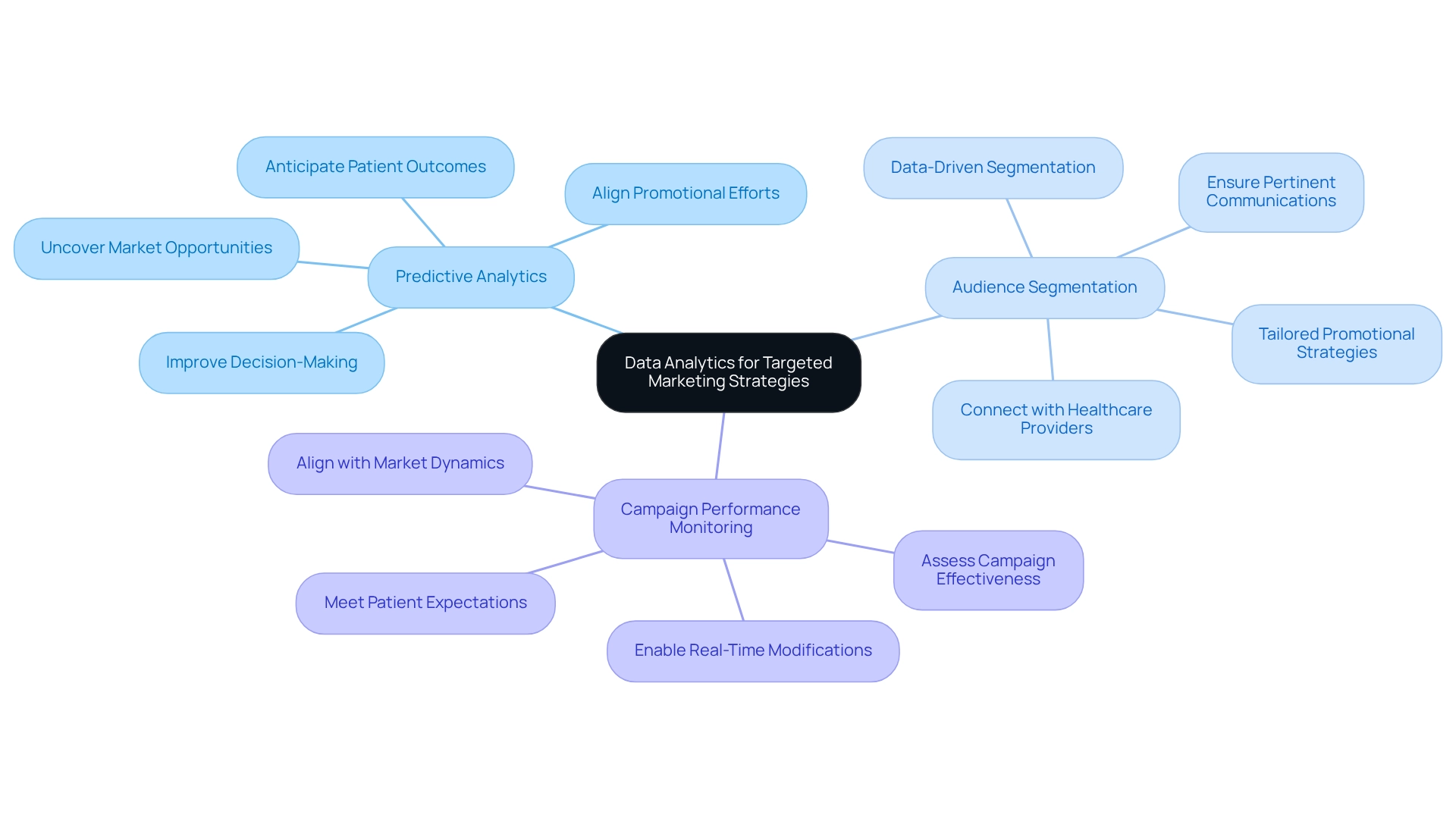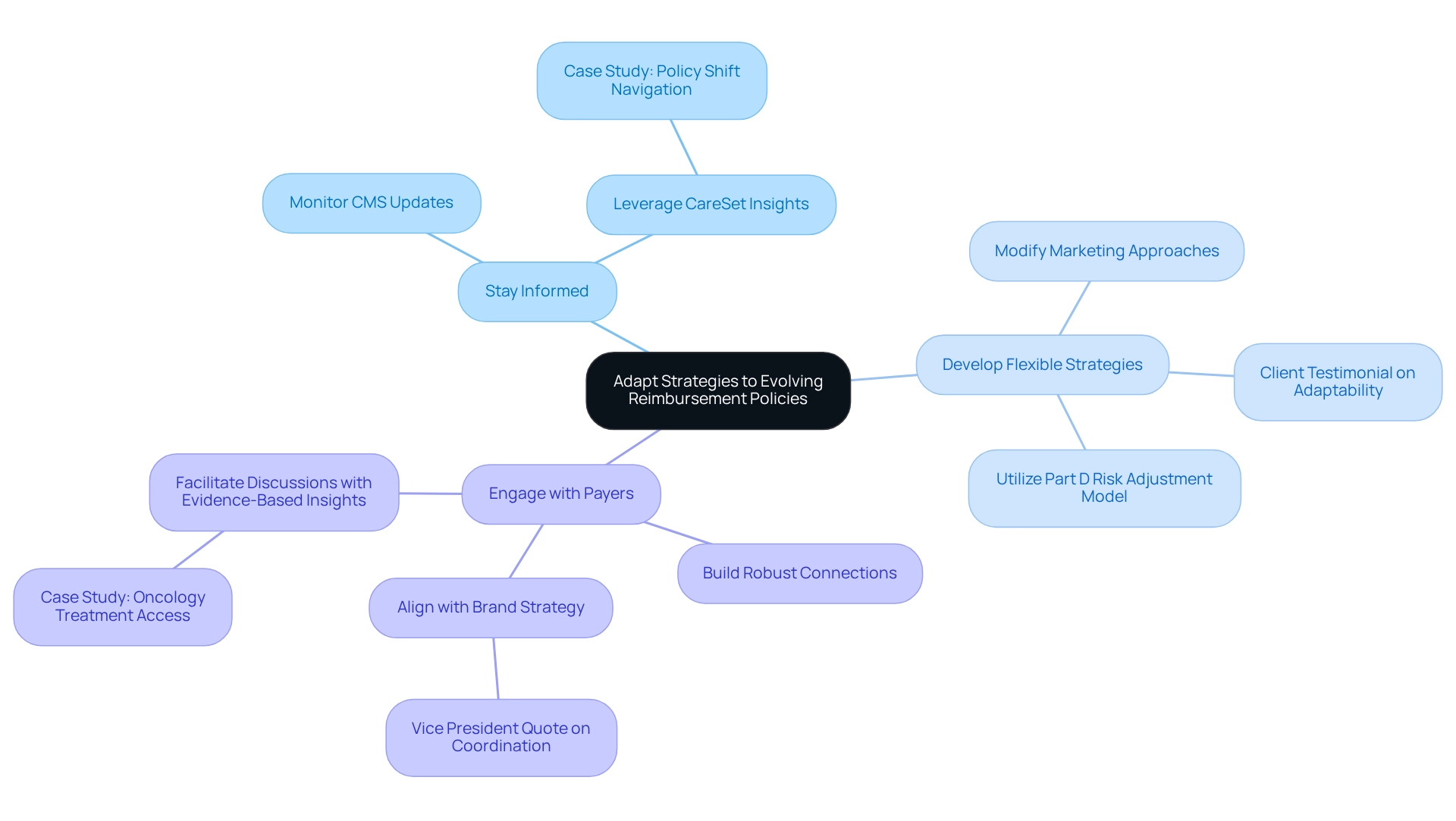Overview
The article delineates four pivotal strategies for effective pharmaceutical marketing in the contemporary landscape:
- Navigating regulatory frameworks
- Engaging stakeholders
- Leveraging data analytics
- Adapting to evolving reimbursement policies
These strategies underscore the critical importance of:
- Compliance
- Fostering stakeholder collaboration
- Employing data-driven decision-making
- Maintaining flexibility in response to policy changes
Collectively, these elements are essential for enhancing market access and patient engagement within the pharmaceutical industry.
Introduction
In the competitive landscape of the pharmaceutical industry, understanding and navigating the complex regulatory frameworks is paramount for successful marketing. As companies strive to promote their products effectively while adhering to stringent guidelines set forth by bodies like the FDA, the need for innovative strategies becomes increasingly clear.
Leveraging data analytics to enhance audience targeting and fostering robust stakeholder engagement are essential components of a multifaceted approach. This approach not only complies with regulations but also resonates with healthcare providers and patients alike.
This article delves into essential strategies that can empower pharmaceutical companies to thrive in a rapidly evolving environment, ensuring their products reach the market while maintaining ethical standards and improving patient accessibility.
Navigate Regulatory Frameworks for Effective Pharma Marketing
Navigating the intricate regulatory frameworks governing pharmaceutical promotion is crucial for achieving success in the industry. Marketers must be well-versed in the guidelines established by the FDA and other regulatory bodies, which dictate the permissible methods of product advertising. Key strategies for effective navigation include:
- Stay Updated: Regularly monitor updates from regulatory agencies to ensure compliance with the latest advertising standards. This is particularly vital considering recent FDA guidelines for 2025, which emphasize ethical decision-making in promotional practices. For instance, Gilead Sciences utilizes advanced algorithms to target healthcare professionals with content relevant to their specialties, showcasing the importance of data-driven strategies.
- Training and Resources: Invest in comprehensive training for promotional teams on compliance issues. This fosters a culture of adherence to regulations and equips teams with the knowledge necessary to navigate the evolving landscape.
- Collaborate with Legal Teams: Engage closely with legal advisors to review promotional materials prior to public release. This collaboration ensures that all content meets regulatory requirements, thereby minimizing the risk of non-compliance.
Integrating video content into promotional approaches has demonstrated success, as evidenced in case studies where pharmaceutical firms employed video to clarify intricate medical concepts and convey patient narratives. This approach not only enhances comprehension and retention but also aligns with current FDA guidelines, making it a valuable tool for compliance and engagement. A specific case study titled “Video Content in Pharma Marketing” illustrates how video can boost the overall effectiveness of campaigns.
As Bianca Belman-Adams, a Content Marketing and Organic Growth Specialist, notes, “Pharmaceutical marketing is evolving rapidly,” underscoring the need for marketers to adapt to these changes. Furthermore, platforms such as Kaltura facilitate the distribution of video content via live-streaming events and on-demand educational sessions, offering valuable resources for marketers aiming to adopt video approaches in accordance with FDA guidelines.
By applying these approaches, drug companies can skillfully maneuver through the regulatory environment while marketing their products ethically, ultimately resulting in enhanced market access and patient involvement.

Engage Stakeholders to Enhance Product Accessibility
Effective stakeholder engagement is essential for improving product accessibility in the pharmaceutical industry. Focused approaches can significantly enhance cooperation and outcomes.
Identify Key Stakeholders: Begin by outlining essential stakeholders, including healthcare providers, patient advocacy groups, and payers. Understanding their roles and impacts is crucial for developing effective access plans. Engaging with these groups can unveil insights into their needs and expectations, which are vital for aligning products with market demands. CareSet’s comprehensive Medicare information insights, derived from over 62 million beneficiaries and 6 million providers, empower stakeholders by providing valuable knowledge that enhances decision-making.
Foster Open Communication: Establishing regular communication channels with stakeholders is imperative. This ongoing dialogue facilitates the gathering of valuable feedback and insights that can guide marketing pharma plans. Strong communication builds trust and fosters a deeper understanding of stakeholder perspectives, essential for successful product positioning. Recent studies indicate that effective stakeholder management requires robust communication and interpersonal skills to cultivate trustful relationships. Utilizing CareSet’s information can enhance these communications by offering stakeholders relevant insights tailored to their needs.
Collaborative Initiatives: Creating joint initiatives with stakeholders can effectively address barriers to access. For instance, educational programs and community outreach efforts can enhance awareness and understanding of products among healthcare providers and patients. Such collaborations not only improve product visibility but also foster a sense of shared purpose in overcoming accessibility challenges. The MuSE Consortium’s focus on enhancing Patient and Public Involvement (PPI) in health guideline development exemplifies how stakeholder engagement can lead to improved health outcomes. By leveraging CareSet’s expertise, drug companies can develop targeted initiatives that resonate with healthcare providers and patients alike. Actively involving stakeholders through these marketing pharma approaches allows drug companies to better align their offerings with market demands, ultimately enhancing accessibility for patients and improving health results. Furthermore, adhering to detailed guidelines, such as the RIGHT checklist, which outlines 22 items concerning reporting, underscores the significance of extensive stakeholder involvement in ensuring successful promotional strategies.

Leverage Data Analytics for Targeted Marketing Strategies
Utilizing analytics is essential for developing focused marketing pharma strategies in the pharmaceutical industry. Key practices include:
- Utilize Predictive Analytics: Implement predictive analytics to anticipate patient outcomes and uncover potential market opportunities by examining historical information. This approach not only improves decision-making but also aligns promotional efforts with patient needs, ultimately driving better engagement.
- Segment Audiences: Employ data-driven audience segmentation based on demographics, prescribing behaviors, and treatment patterns. This enables tailored promotional strategies that connect more efficiently with healthcare providers and patients, ensuring that communications are pertinent and influential.
- Monitor Campaign Performance: Continuously assess campaign information to measure effectiveness and enable real-time modifications to strategies. This iterative process ensures that marketing efforts remain aligned with evolving market dynamics and patient expectations.
In 2025, delivering tailored messages to individual patients and healthcare providers is not just beneficial; it is a necessity. By harnessing the power of analytics, marketing pharma professionals can create more effective, targeted campaigns that resonate deeply with their audiences, ultimately improving patient outcomes and optimizing the lifecycle management of pharmaceutical products. The dedication to information quality and transparency, as demonstrated by industry leaders such as CareSet, guarantees that clients obtain timely insights that foster strategic growth. For example, CareSet’s groundbreaking data science offerings, including their sophisticated predictive analytics tools and audience segmentation features, have allowed clients to uncover new market opportunities and enhance their promotional approaches. Moreover, these technologies are crucial for enhancing resource allocation in drug distribution, emphasizing the significance of data-driven methods in today’s medical landscape.

Adapt Strategies to Evolving Reimbursement Policies
Adjusting marketing pharma approaches to changing reimbursement policies is crucial for drug companies seeking to sustain market access. Key strategies to consider include:
-
Stay Informed: Regularly monitor updates from the Centers for Medicare & Medicaid Services (CMS) and other relevant organizations regarding changes in reimbursement policies. Keeping informed about these developments is essential, particularly with recent updates in April 2025 that indicate changes in reimbursement frameworks impacting medications. Leveraging CareSet’s comprehensive Medicare data insights provides valuable context for these changes, empowering companies to make informed decisions. A recent case study highlighted how a pharmaceutical company utilized CareSet’s insights to navigate a significant policy shift, resulting in improved engagement with healthcare providers.
-
Develop flexible strategies in your marketing pharma approaches that can be swiftly modified in response to fluctuations in reimbursement rates or policy changes. The completed Part D risk adjustment model for CY 2025 emphasizes the significance of modifying approaches to guarantee precise bids and sustainable benefits for enrollees. Leveraging insights from CareSet’s information solutions, which include details from more than 62 million beneficiaries and 6 million providers, can improve the adaptability and efficiency of these approaches in a changing environment. A client testimonial remarked, ‘CareSet’s data enabled us to adjust our approach swiftly, ensuring we stayed competitive despite evolving reimbursement environments.’
-
Engage with Payers: Build robust connections with payers to understand their viewpoints and integrate their feedback into promotional plans. A vice president in market access emphasized the importance of aligning and coordinating across functions with the overarching brand strategy. This engagement ensures alignment with reimbursement criteria and enhances the likelihood of successful product access. CareSet’s information leadership in healthcare analytics can facilitate these discussions by providing evidence-based insights that resonate with payer expectations. A case study on oncology treatment options illustrated how effective payer engagement, backed by CareSet’s information, led to enhanced access for a new therapy.
By proactively adapting to reimbursement changes and leveraging CareSet’s comprehensive Medicare data insights, pharmaceutical companies can protect their market access and ensure that their marketing pharma strategies keep their products accessible to patients. The industry’s average risk score trends indicate that individual plans may experience varying impacts, underscoring the need for tailored strategies that reflect specific market conditions. Furthermore, therapeutic archetypes can simplify the creation of customized launch plans, allowing companies in marketing pharma to better navigate the complexities of reimbursement policies and enhance their overall effectiveness.

Conclusion
Navigating pharmaceutical marketing effectively necessitates a profound understanding of regulatory frameworks, stakeholder engagement, data analytics, and adaptability to reimbursement policies. Compliance with FDA guidelines is paramount; remaining informed, investing in team training, and collaborating with legal advisors are essential to ensure that marketing strategies align with regulations while effectively reaching healthcare providers and patients.
Engaging stakeholders—such as healthcare providers, patient advocacy groups, and payers—is crucial for enhancing product accessibility. Open communication and collaborative initiatives foster trust and provide valuable insights to align offerings with market needs, ultimately improving health outcomes.
Data analytics plays a vital role in crafting targeted marketing strategies. By leveraging predictive analytics, segmenting audiences, and monitoring campaign performance, pharmaceutical marketers can develop personalized communications that resonate with their target audiences. This approach guarantees that marketing efforts are both relevant and impactful.
Adapting to evolving reimbursement policies is equally critical for maintaining market access. Staying abreast of policy changes, developing flexible strategies, and engaging with payers empower companies to navigate the shifting landscape effectively. This proactive approach safeguards market access and ensures that products remain available to patients.
In conclusion, the integration of regulatory compliance, stakeholder engagement, data analytics, and reimbursement adaptability is essential for success in pharmaceutical marketing. By embracing these strategies, companies can excel in a competitive environment while enhancing patient accessibility and health outcomes, ultimately benefiting the healthcare landscape as a whole.

